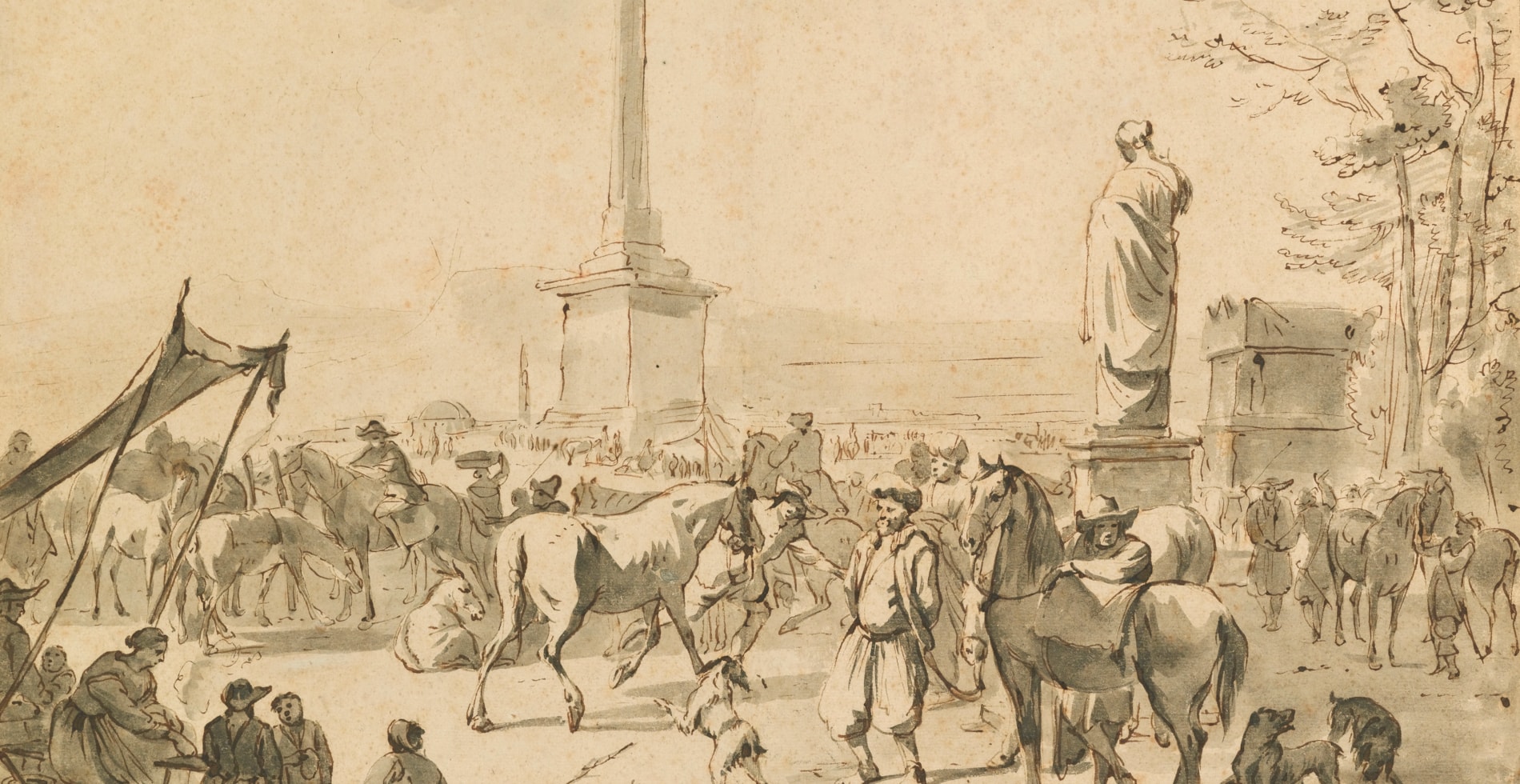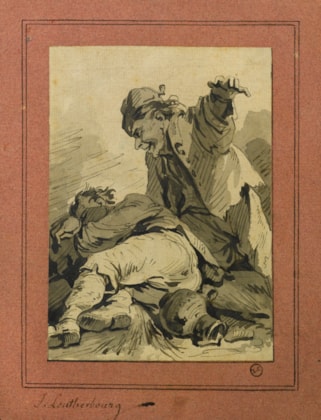endrik Verschuring
(Gorinchem 1627 - Dordrecht 1690)
A Horse Market with Arabian Merchants in the Campo Vaccino, Rome
signed with a monogram in brown ink ‘HVS. f.’ (lower left)
pen and brown ink and grey wash with touches of black chalk, within brown ink framing lines
31 x 41.5 cm (12¼ x 16¼ in)
Hendrik Verschuring made his reputation with equestrian drawings, of which A Horse Market with Arabian Merchants in the Campo Vaccino, Rome is a fine example. The fair in the Campo Vaccino was a subject that the artist clearly favoured, perhaps as it provided an opportunity to highlight the magnificence of his horses, by portraying them surrounded by noble and timeless remnants of classical architecture. Several of his drawings show the same setting from different vantage points, one of which is in the Royal Collection at Windsor.¹
The Campo Vaccino was a name designated in the Middle Ages to an area of the Roman Forum located between the Capitoline Hill and the Colosseum that was traditionally used as a cattle market. During Verschuring’s time, some of the Forum’s most impressive ruins would have been covered with several metres of eroded soil, much of it created by the new building projects in the Baroque period, and it was not until the Napoleonic regime that excavations of the city began. Many of the monuments that define the Forum today do not appear in the artist’s drawings, perhaps out of artistic preference, but most likely because they were as yet undiscovered. The column at the centre of the present drawing is distinctive in its free-standing isolation and is probably the Column of Phocas, a landmark often depicted in vedute and engravings. The column was the last addition to the Forum erected in honour of the Byzantine emperor Phocas in 608 AD.
Another drawing of the Campo Vaccino by Verschuring (Private Collection, UK), from a different angle, prominently features the three columns of the Temple of the Dioscuri. This ruin of antiquity, like the Column of Phocas and the classical statue in the present work, gives the composition greater definition and elevates the subject matter. The crowded lower ground of both works is typical of Verschuring, as is the fluidity and hasty expressiveness of his pen and the dashes of grey wash that so dramatically indicate shadow. In both examples, he further punctuates the lines with touches of black chalk.
Verschuring was a pupil of Jan Both (c.1615-1652) in Utrecht before travelling to Italy in c.1650. He remained in Rome for a considerable length of time, only returning to Holland in 1662. In his maturity, he achieved considerable renown for his paintings of Italianate equestrian and battle scenes in a style similar to that of Philips Wouwerman (1619-1668).
¹ See C. White and C. Crawley, The Dutch and Flemish Drawings of the Fifteenth to the Early Nineteenth Centuries in the Collection of Her Majesty the Queen at Windsor Castle, Cambridge 1994, p. 351, cat. no. 488.
Hendrik Verschuring made his reputation with equestrian drawings, of which A Horse Market with Arabian Merchants in the Campo Vaccino, Rome is a fine example. The fair in the Campo Vaccino was a subject that the artist clearly favoured, perhaps as it provided an opportunity to highlight the magnificence of his horses, by portraying them surrounded by noble and timeless remnants of classical architecture. Several of his drawings show the same setting from different vantage points, one of which is in the Royal Collection at Windsor.¹
The Campo Vaccino was a name designated in the Middle Ages to an area of the Roman Forum located between the Capitoline Hill and the Colosseum that was traditionally used as a cattle market. During Verschuring’s time, some of the Forum’s most impressive ruins would have been covered with several metres of eroded soil, much of it created by the new building projects in the Baroque period, and it was not until the Napoleonic regime that excavations of the city began. Many of the monuments that define the Forum today do not appear in the artist’s drawings, perhaps out of artistic preference, but most likely because they were as yet undiscovered. The column at the centre of the present drawing is distinctive in its free-standing isolation and is probably the Column of Phocas, a landmark often depicted in vedute and engravings. The column was the last addition to the Forum erected in honour of the Byzantine emperor Phocas in 608 AD.
Another drawing of the Campo Vaccino by Verschuring (Private Collection, UK), from a different angle, prominently features the three columns of the Temple of the Dioscuri. This ruin of antiquity, like the Column of Phocas and the classical statue in the present work, gives the composition greater definition and elevates the subject matter. The crowded lower ground of both works is typical of Verschuring, as is the fluidity and hasty expressiveness of his pen and the dashes of grey wash that so dramatically indicate shadow. In both examples, he further punctuates the lines with touches of black chalk.
Verschuring was a pupil of Jan Both (c.1615-1652) in Utrecht before travelling to Italy in c.1650. He remained in Rome for a considerable length of time, only returning to Holland in 1662. In his maturity, he achieved considerable renown for his paintings of Italianate equestrian and battle scenes in a style similar to that of Philips Wouwerman (1619-1668).
¹ See C. White and C. Crawley, The Dutch and Flemish Drawings of the Fifteenth to the Early Nineteenth Centuries in the Collection of Her Majesty the Queen at Windsor Castle, Cambridge 1994, p. 351, cat. no. 488.





 contact
contact contact
contact +44 20 7313 8040
+44 20 7313 8040









